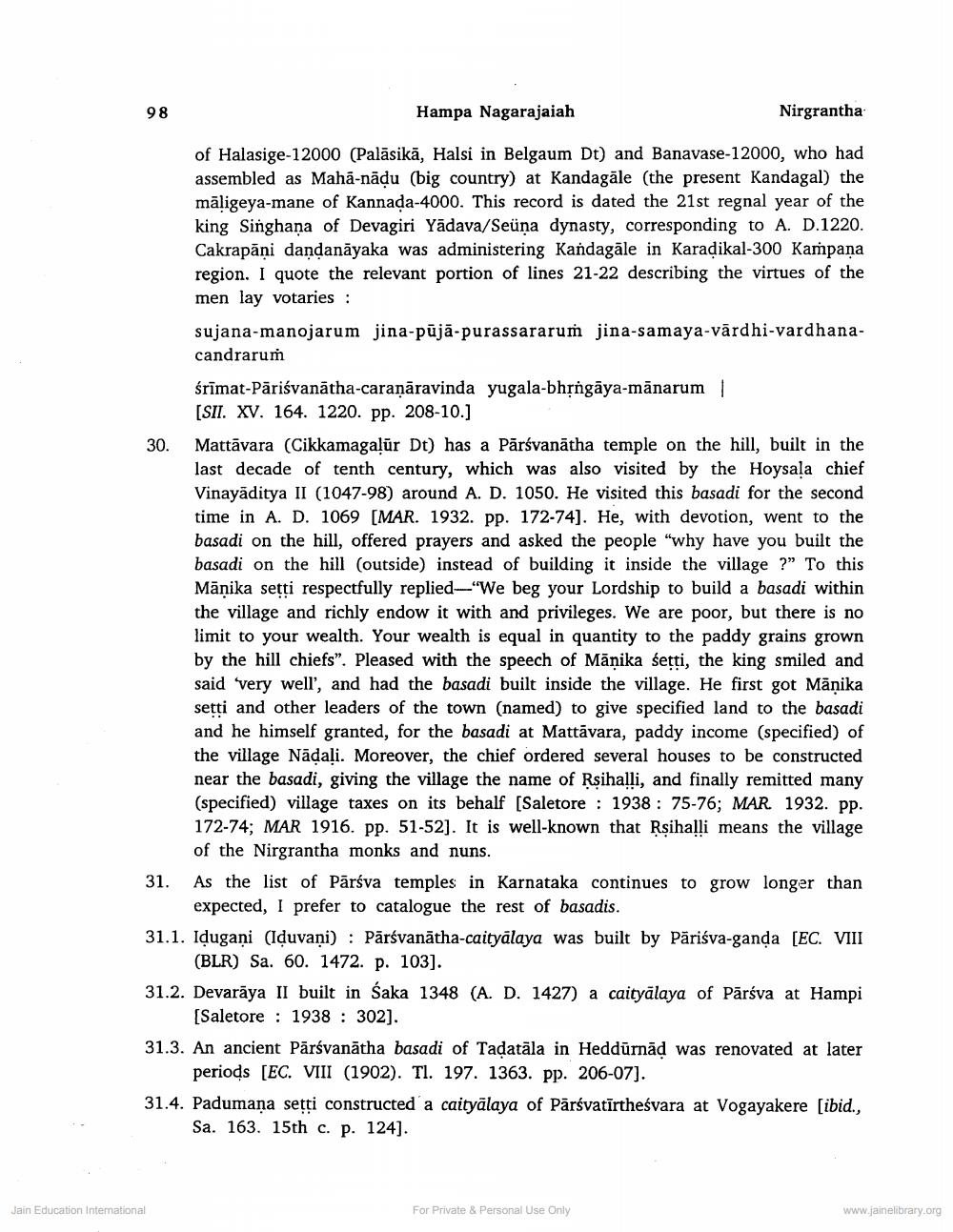________________
98
Hampa Nagarajaiah
Nirgrantha
of Halasige-12000 (Palāsikā, Halsi in Belgaum Dt) and Banavase-12000, who had assembled as Mahā-nādu (big country) at Kandagāle (the present Kandagal) the māligeya-mane of Kannada-4000. This record is dated the 21st regnal year of the king Singhana of Devagiri Yādava/Seüņa dynasty, corresponding to A. D.1220. Cakrapāņi dandanāyaka was administering Kandagāle in Karadikal-300 Kampaņa region. I quote the relevant portion of lines 21-22 describing the virtues of the men lay votaries : sujana-manojarum jina-puja-purassararum jina-samaya-vārdhi-vardhanacandrarum śrīmat-Pāriśvanātha-caraṇāravinda yugala-bhộngāya-mānarum
[SII. XV. 164. 1220. pp. 208-10.) 30. Mattāvara (Cikkamagalur Dt) has a Pārsvanātha temple on the hill, built in the
last decade of tenth century, which was also visited by the Hoysala chief Vinayāditya II (1047-98) around A. D. 1050. He visited this basadi for the second time in A. D. 1069 [MAR. 1932. pp. 172-74]. He, with devotion, went to the basadi on the hill, offered prayers and asked the people "why have you built the basadi on the hill (outside) instead of building it inside the village ?” To this Mānika setti respectfully replied—“We beg your Lordship to build a basadi within the village and richly endow it with and privileges. We are poor, but there is no limit to your wealth. Your wealth is equal in quantity to the paddy grains grown by the hill chiefs". Pleased with the speech of Mānika setti, the king smiled and said very well, and had the basadi built inside the village. He first got Mānika setti and other leaders of the town (named) to give specified land to the basadi and he himself granted, for the basadi at Mattāvara, paddy income (specified) of the village Nadali. Moreover, the chief ordered several houses to be constructed near the basadi, giving the village the name of Rsihalli, and finally remitted many (specified) village taxes on its behalf (Saletore : 1938 : 75-76; MAR. 1932. pp. 172-74; MAR 1916. pp. 51-52]. It is well-known that Rsihalli means the village
of the Nirgrantha monks and nuns. 31. As the list of Pārśva temples in Karnataka continues to grow longer than
expected, I prefer to catalogue the rest of basadis. 31.1. Idugaņi (lduvaņi) : Pārsvanātha-caityālaya was built by Pāriśva-ganda [EC. VIII
(BLR) Sa. 60. 1472. p. 103]. 31.2. Devarāya II built in Saka 1348 (A. D. 1427) a caityālaya of Pārsva at Hampi
[Saletore : 1938 : 302).
31.3. An ancient Pārsvanātha basadi of Tadatāla in Heddūrnād was renovated at later
periods [EC. VIII (1902). Tl. 197. 1363. pp. 206-07]. 31.4. Padumana setti constructed a caityālaya of Pārsvatīrtheśvara at Vogayakere (ibid.,
Sa. 163. 15th c. p. 124].
Jain Education Intemational
For Private & Personal Use Only
www.jainelibrary.org




